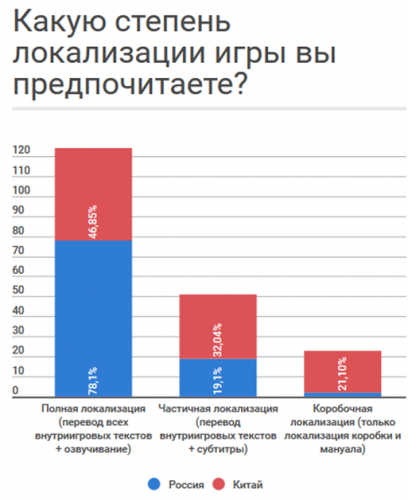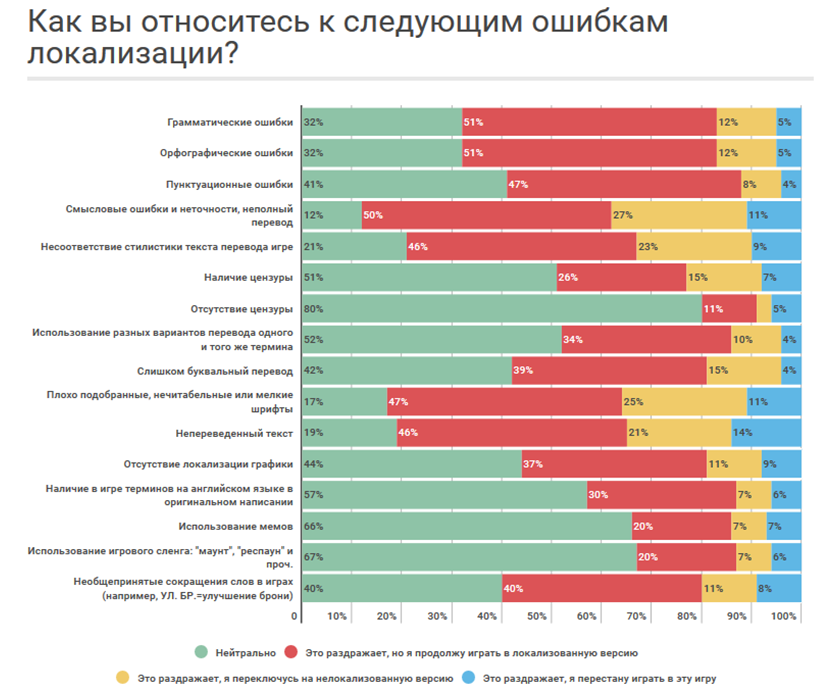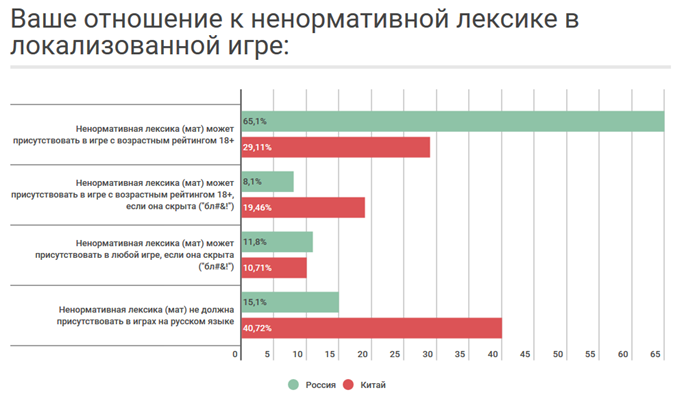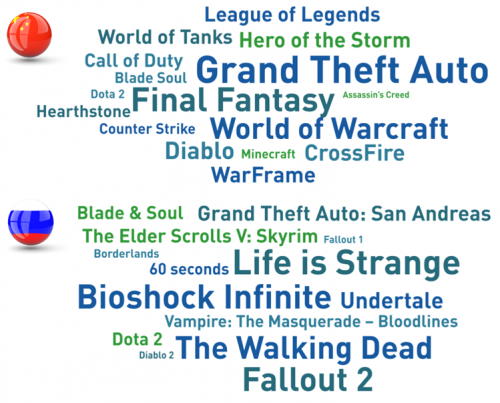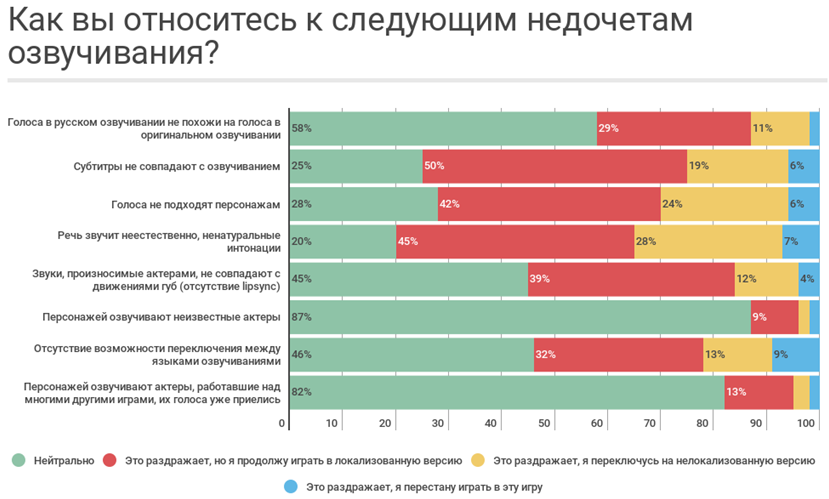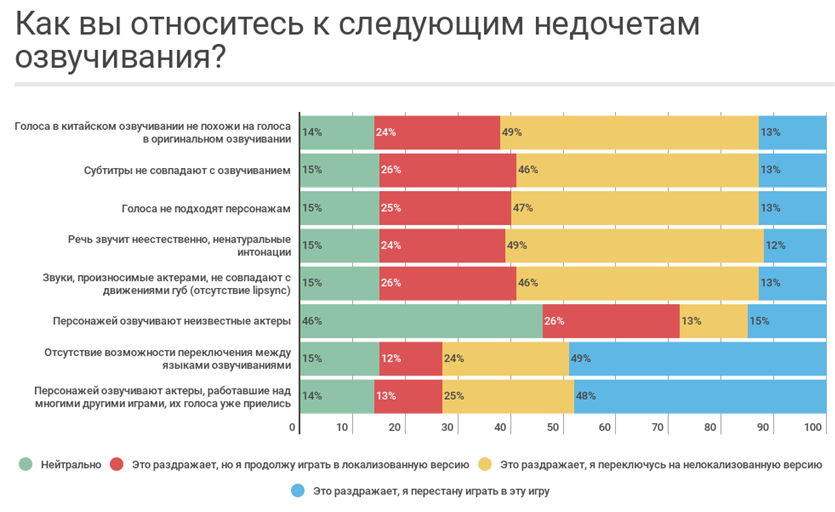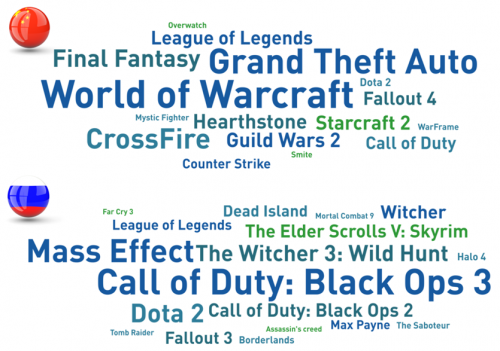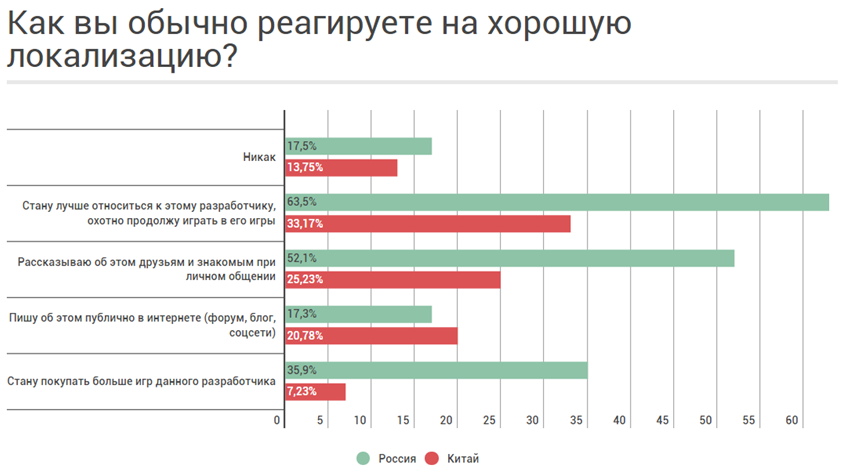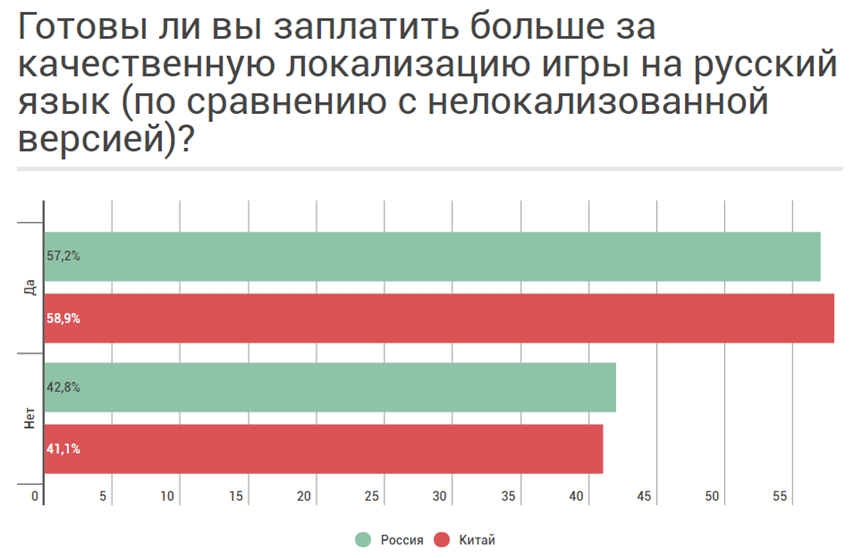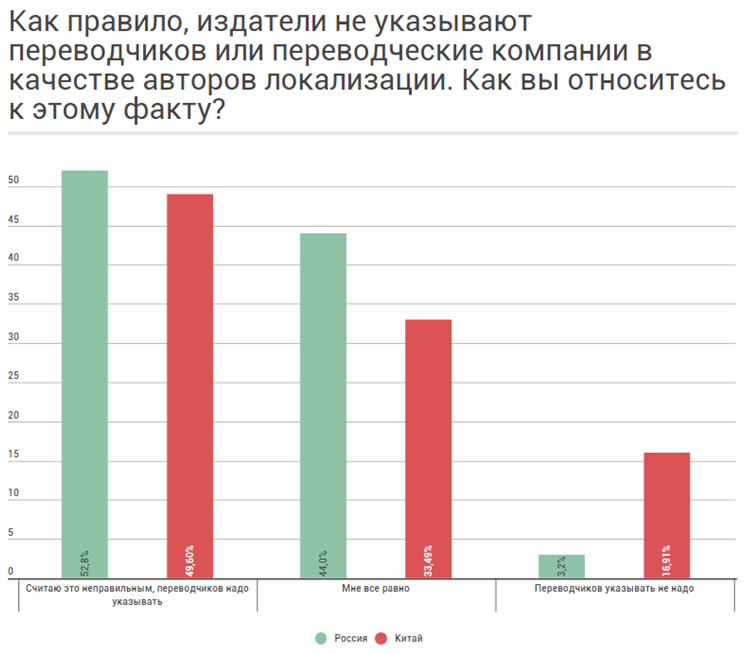"What is good localization?": comparison of Chinese and Russian views
How users of Russia and China relate to game abbreviations, mat and small print in localizations, the company All Correct Games told.
To the question “What is good localization?” we first tried to answer two years ago. Then we launched the first wave of the survey of Russian players. We had two goals: to find out what localization problems end users highlight, and to prove to the gaming community that the translators of the game are no less interested in its success than the creators.
The players were willing to share their opinions, because we touched on an important topic for them. The developers did not stand aside either: they became interested in the survey when we shared its results at international gaming conferences.
We realized that we need to analyze new markets and find like-minded people. So there was a working group, which besides us includes the largest game developers: Nintendo, Ubisoft, EA, Wooga, Sony, Zynga, Bigpoint. We regularly exchange opinions and ideas, discuss the news of the project and plan its development.
So, in 2016, we conducted a survey among Chinese players for the first time. And now we want to tell you more about it.
Why China was chosen as the country of study, we wrote a little earlier. Recall that our December article on App2Top was devoted to the differences between Chinese and Russian players from each other in general, without reference to the topic of localization.
Degree of localization
The question of whether our respondents prefer to play the original or localized version is, of course, related to the question of knowledge of the English language. Only 5% of Russian players choose the original (English) version. For Chinese players, this figure is much higher — 30%.
Most players in both countries prefer full localization.
At the same time, unlike our compatriots, many of whom claim to read all the texts found in the game, Chinese players (about 58%) admitted that the process of passing is more important for them.
Cultural aspect
This point can be characterized by the well—known saying “The best is the enemy of the good.” Full adaptation of graphic elements, as well as cultural features of the game, is not always encouraged by end users, and the survey results confirm this. Respondents from Russia and China unanimously argue that it is worth adapting only the key points of the game, as well as those that may be negatively perceived in the country of the target language.
Text Analysis
We decided to find out which types of errors interfere with the passage of the game and spoil the impression of it. Interestingly, the opinion of end users on this score differs from ours. At All Correct, we attribute non-compliance with the glossary, spelling and grammatical flaws to critical errors. And although Russian players also notice such translation flaws, they still continue to play the localized version. What can make them switch to the original version of the game? Untranslated text, semantic errors, as well as incorrectly chosen style of presentation.
Chinese players are less tolerant of all the errors listed below. They consider the lack of censorship, the use of generally accepted abbreviations and unreadable fonts, as well as the inconsistency of the style with the original to be the most significant shortcomings.
Russia:
China:
Let’s move on to the question of how end users relate to the use of profanity in game texts. Here the opinions of Chinese and Russian respondents differ. The former believe that strong expressions have no place in games. The latter are in favor of preserving the obscene vocabulary in translation, if it is present in the original. Perhaps the reason for such a different attitude to the mat is that Russian culture is more influenced by Western than Chinese, so our compatriots perceive obscene words and expressions in games more easily.
Another small discovery: players from both countries are ready to give developers feedback on the quality of localization, but often do not know exactly how to do it.
Fan localization
Probably, every person connected with localization in one way or another has ever wondered whether fans of the game can translate it themselves and do it qualitatively. We even conducted a separate study on this topic, but we were interested to find out what the players themselves think about fan localization. Surprisingly, almost none of them could give an example of a successful unofficial localization. Here are the names of some of the games that the respondents remembered:
Voice acting
An interesting fact: the majority of Chinese respondents prefer English dubbing to Chinese (about 74%), while Russian players choose dubbing in their native language (about 70%). It’s hard to say what this is related to. Maybe there aren’t many well-voiced games on the Chinese market?
Russian players are most annoyed by unnatural intonations and poorly chosen voices. At the same time, the level of celebrity of the voice actors and the incomplete coincidence of the tonality of the voices in the original and translation are not so important for them.
Chinese players were more categorical. Most of all, they do not like it when the characters are voiced by actors known for many other roles, as well as if there is no opportunity to switch to the original version.
Russia:
China:
Among the most successful games in terms of voicing , Russian and Chinese respondents distinguish:
Among the unsuccessful examples of voicing were:
It is easy to notice that the same game is often cited as an example of both bad and good voice acting. It seems that tastes really do not argue.
What if the game failed?
This time we added a few questions to find out how players react to high-quality and low-quality localization.
Judging by the answers to one of them, a bad translation directly affects the popularity of the developer. Both Russians and Chinese intend to share negative impressions with friends or on social networks and even stop buying the company’s games! This means that just one poorly localized game can negatively affect both the image of the developer and his earnings.
There is also good news. If the game was localized at the proper level, its fans are happy to support the developer: buy other games of the company, as well as leave positive feedback on various resources. Russian players are more active in this regard than Chinese ones.
But both are willing to pay more for a game that is qualitatively translated into their native language than for its original version. In addition, they are ready to buy a game that has been re-released with a better localization.
We need to know our heroes. Or not?
Usually developers do not indicate in the titles the names of the localization companies and the names of the translators who worked on the project. We decided to find out from the players how fair this is. The majority of Chinese and Russian respondents believe that the specialists who translated the game should be listed in the credits, which we cannot disagree with.
Hypotheses
Let’s share with you a few hypotheses that we have tested based on the responses of Chinese players.
– “Non-hardcore” players (those who play less than 10 hours a week) are more tolerant of localization errors.
That’s not so. The attitude of the players to the errors noticed does not depend on the time spent in the game.
– Young players are more tolerant of localization errors.
And again, no. There is no direct relationship between the age of the players and their attitude to mistakes.
– Players with a higher level of English proficiency prefer to play the original version.
This hypothesis was confirmed. For us, this is a reason to strive to ensure that the localized version of the game is even a little better than the original one.
– Female players react more acutely to the translation of appeals to the player without regard to gender.
Surprisingly, this is not true. Undifferentiated treatment does not suit players of both sexes.
– Players who prefer to play RPG pay less attention to unusual abbreviations.
The hypothesis was not confirmed. Fans of arcades and puzzles turned out to be the most tolerant, but fans of simulators and economic strategies, judging by their answers, are irreconcilable opponents of cuts.
What’s next?
We plan to identify new markets for our research, as well as to study in more detail some aspects and controversial issues. The more information we collect, the higher the value of our research will be. This means that it will be easier to meet the expectations of the players.
But already now we can identify several points that will help localizer and developers to create a quality product together.
1. Filling out the terms of reference. We believe that this is a necessary measure to facilitate the process of translating and voicing the text. It is especially important to fill in the fields related to the style of the game and its origin: this will help localizers convey its atmosphere.
2. Providing reasonable deadlines. A fairly obvious point, but at the same time very significant. After all, the more time a translator has to complete a task, the more thoroughly he will study all the subtleties of the project, and this directly affects the quality of the localized version.
3. Issuance of reference materials. Any information about the game will be very useful to the localizer. Character descriptions, images of objects, glossaries, builds, films or books that inspired the developers will be extremely useful — everything that can help us to handle the original text as carefully as possible.
4. Constant interaction. At All Correct, we pay special attention to establishing effective communication with the customer during the translation process. The faster we get the necessary information, the fewer edits will need to be made at the testing stage of the game.
5. Preparing the game for localization. Even before the translation, it is worth taking care of font support and spacious text windows, as well as setting variables taking into account grammatical forms.
Thanks to the second stage of our survey, we began to better understand communities that are different in culture, but similar in their love for games, which means that now we are one step closer to resolving controversial issues and building a dialogue between developers and localizers. We hope that this small contribution to the development of video games will help to achieve full mutual understanding between players and game creators from different countries.

